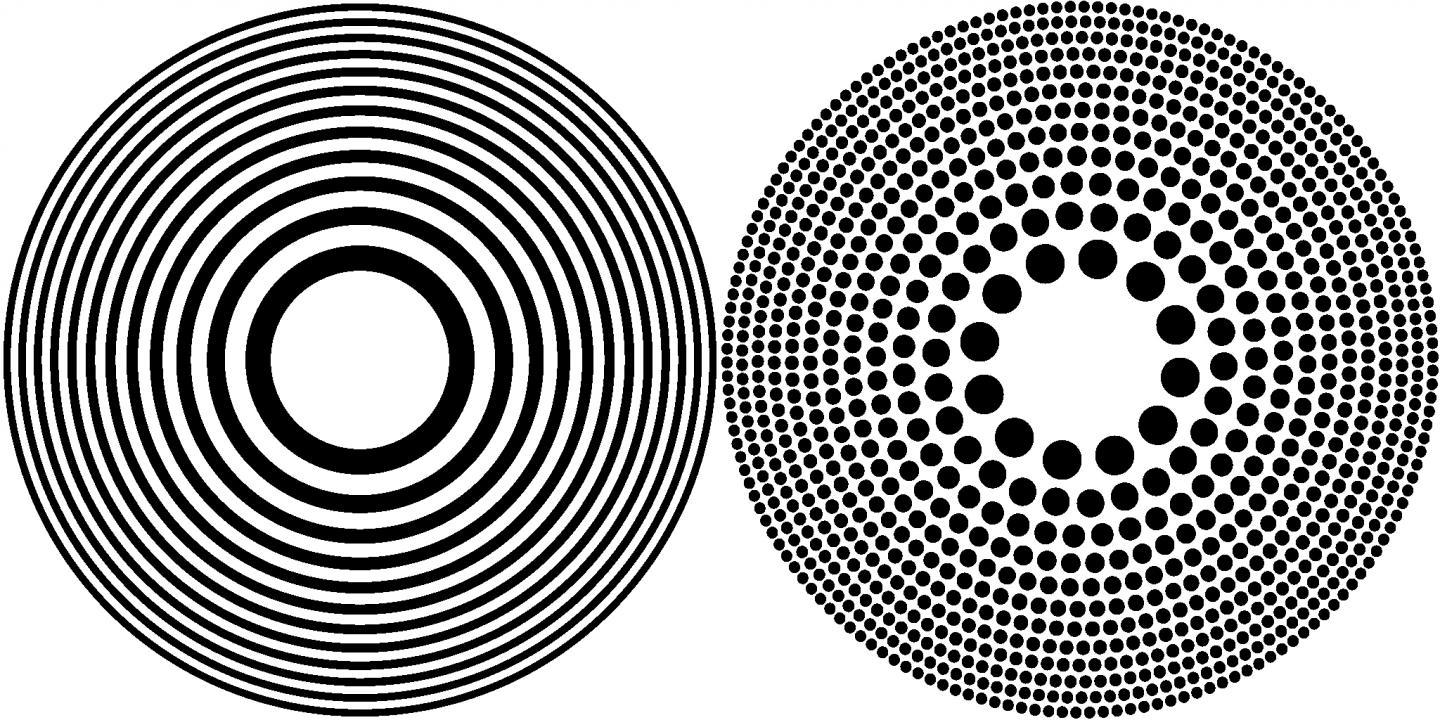
This drawing shows the differences between Fresnel zone plates and the photon sieve. The latter is dotted with millions of precisely machined holes. Source: NASA
It’s an age-old astronomical truth: To resolve smaller and smaller physical details of distant celestial objects, scientists need larger and larger light-collecting mirrors. This challenge is not easily overcome given the high cost and impracticality of building and — in the case of space observatories — launching large-aperture telescopes.
However, a team of scientists and engineers at NASA’s Goddard Space Flight Center in Greenbelt, Maryland, has begun testing a potentially more affordable alternative called the photon sieve. This new-fangled telescope optic could give scientists the resolution they need to see finer details still invisible with current observing tools – a jump in resolution that could help answer a 50-year-old question about the physical processes heating the sun’s million-degree corona.
Although potentially useful at all wavelengths, the team specifically is developing the photon sieve for studies of the sun in the ultraviolet, the wavelengths needed to disentangle the coronal heating mystery. With support from Goddard’s Research and Development program, the team has fabricated three sieves and now plans to begin testing to see if it can withstand the rigors of operating in space — milestones achieved in less than a year. “This is already a success,” said Doug Rabin, who is leading the R&D initiative.
Variant of Fresnel Zone Plate
The optic is a variant of something called a Fresnel zone plate. Rather than focusing light as most telescopes do through refraction or reflection, Fresnel plates cause light to diffract — a phenomenon that happens when light travels through a thin opening and then spreads out. This causes the light waves on the other side to reinforce or cancel each other out in precise patterns.
Fresnel plates consist of a tightly spaced set of rings, alternatingly transparent or opaque. Light travels through the spaces between the opaque zones, which are precisely spaced so that the diffracted light overlaps and focuses at a specific point, creating an image that can be recorded by a solid-state sensor.
The photon sieve operates largely the same. However, the sieve is dotted with millions of holes precisely placed on silicon in a circular pattern that takes the place of conventional Fresnel zones.
The team wants to build a photon sieve at least three feet, or one meter, in diameter — a size they think could achieve up to 100 times better angular resolution in the ultraviolet than NASA’s high-resolution space telescope, the Solar Dynamics Observatory.
“For more than 50 years, the central unanswered question in solar coronal science has been to understand how energy transported from below is able to heat the corona,” Rabin said. “Current instruments have spatial resolutions about 100 times larger than the features that must be observed to understand this process.”
Rabin believes his team is well along the way in building an optic that can help answer the question.
Millions of Holes
In just a few months’ time, his team built three devices measuring three inches wide — five times larger than the initial 17-millimeter optic developed four years ago under a previous R&D-funded effort. Each device contains 16 million holes whose sizes and locations were determined by team member Adrian Daw. Another team member, Kevin Denis, then etched the holes in a silicon wafer to Daw’s exacting specifications using a fabrication technique called photolithography.
Team members Anne-Marie Novo-Gradac and John O’Neill have acquired optical images with the new photon sieves, while Tom Widmyer and Greg Woytko have prepared them for vibration testing to make sure they can survive harsh g-forces encountered during launch.
“This testing is to prove that the photon sieve will work as well as theory predicts,” Rabin said. Although the team has already accomplished nearly all the goals it set forth when work began late last year, Rabin believes the team can enlarge the optics by a factor of two before the end of the fiscal year.
Formation-Flying CubeSat
But the work likely won’t end there. In the nearer term, Rabin believes his team can mature the technology for a potential sounding-rocket demonstration. In the longer term, he and team member Joe Davila envision the optic flying on a two-spacecraft formation-flying CubeSat-type mission designed specifically to study the sun’s corona.
“The scientific payoff is a feasible and cost-effective means of achieving the resolution necessary to answer a key problem in solar physics,” he said.




